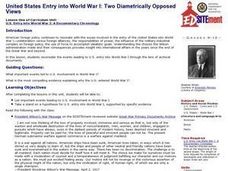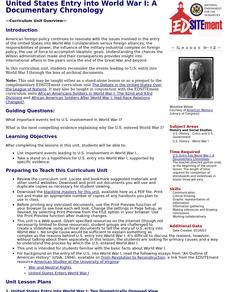Curated OER
United States Entry into World War I: Two Diametrically Opposed Views
Learners analyze the events leading to U.S. entry into World War I. They read a speech by President Wilson and an opposition speech, list the reasons each gives for American entry into the war, and complete a Venn diagram.
Curated OER
United States Entry into World War I: A Documentary Chronology
Students complete a unit of lessons on the events that led to U.S. involvement in WWI. They complete a Webquest, conduct research, complete a Venn diagram, read and discuss the reasons for entering the war, and create a slideshow.
Curated OER
United States Entry into World War I: Some Hypotheses About U.S. Entry
Young scholars determine the most compelling evidence explaining why the U.S. entered WWI. They read and discuss a handout of reasons why the U.S. entered the war, and take a poll as to which reason was the most compelling.
Curated OER
Causes of World War I Worksheet
In this World War I worksheet, students complete a graphic organizer with details about the long and short term causes of the war.
Curated OER
Reasons for the United States Entry into World War I
For this World War I worksheet, students complete a graphic organizer with details about the U.S. neutrality, German submarine warfare, and the Zimmerman telegram.
National Endowment for the Humanities
Neh: Edsit Ement: Woodrow Wilson and Foreign Policy
A thorough review of Woodrow Wilson's foreign policies in these four lessons offered by EDSITEment. Learn the origins of "Wilsonianism," Wilson's views on relations with countries in Latin America, Wilson's decision to enter World War I,...
University of Virginia
Miller Center at Uva: u.s. Presidents: Woodrow Wilson: Foreign Affairs
A discussion of Woodrow Wilson's foreign policies, including Moral Diplomacy, involvement in World War I, and his dream of a League of Nations.








